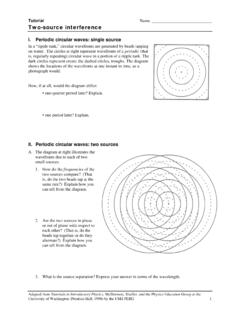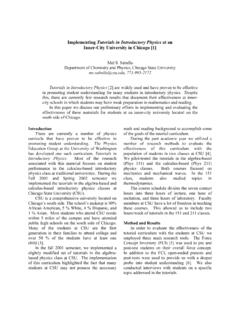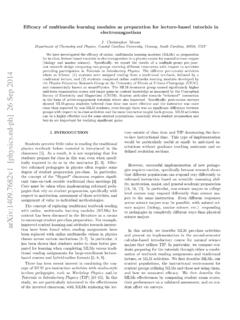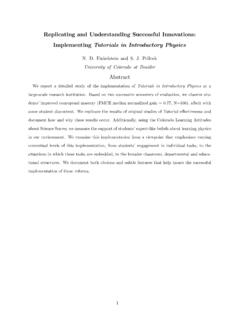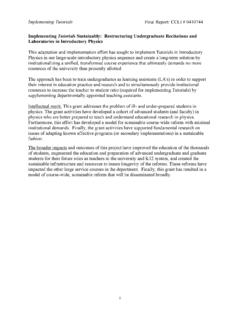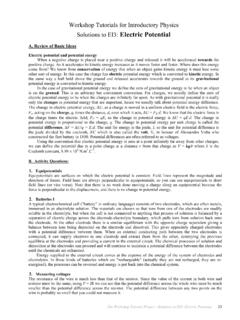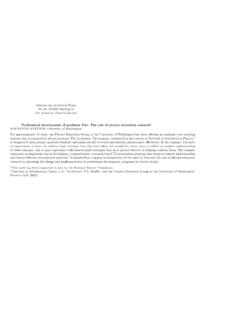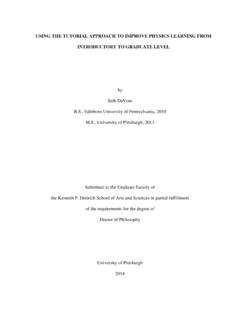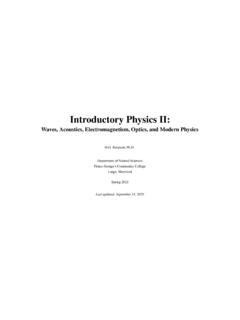Transcription of Tutorial Electric Circuits I - UMD Physics
1 Tutorial Name Electric Circuits I Adapted in Fall 2006 from tutorials in introductory Physics , McDermott, Shaffer, and , U. Wash. Prentice Hall, Inc. First Edition, 2002. 4-1 I. Lighting a bulb A. Work individually for this part. In the space at right, sketch how you could light a small flashlight bulb using a battery, a single wire, and a light bulb. (Your instructor can show you the equipment if you like.) Show the details of the bulb and battery in your sketch and explain your reasoning. If it is not possible to light a bulb with a battery and one wire, explain why not.
2 B. Compare your reasoning with that of your partners. You don t have to agree with one another, but discuss your answers until you understand each others reasoning. C. Obtain a battery, bulb, and wire from your instructor. Connect them in as many ways as you can. For each arrangement, note whether the bulb lights or does not light. Sketching each arrangement will help you to be systematic. Arrangements that light the bulb Arrangements that do not light the bulb D. Find at least four different arrangements that light the bulb. How are they similar? How are they different from arrangements in which the bulb fails to light? Initial idea for how to light a bulb Tutorial : Electric Circuits I Adapted in Fall 2006 from tutorials in introductory Physics , McDermott, Shaffer, and , U.
3 Wash. Prentice Hall, Inc. First Edition, 2002. 4-2 II. Building a model for battery and bulb Circuits A. Examine a light bulb closely. If possible, examine one of the large broken bulbs, perhaps with a magnifying glass. Where do the wires on either side of the filament originate? Sketch what you find. B. Light a bulb using a battery and two wires. 1. Observe and record the brightness of the bulb when objects made out of various materials are inserted into the circuit . (Try copper, paper, iron, steel, plastic, glass, aluminum, rubber, and whatever else you have handy.) Does the bulb continue to glow brightly or does it go out? 2. Classify your materials into different categories according to their effect on the bulb.
4 What do most of the objects that let the bulb light have in common? An object that allows the bulb to glow brightly is called a conductor. An object that makes the bulb go out is called an insulator. Some objects fall between these two categories. C. For convenience, light bulbs are usually placed in sockets. Carefully examine a socket. Identify the conducting and insulating parts. Determine which of the conducting parts are connected to one another. D. What s your thinking about how battery-bulb Circuits work? What do you think is going on in arrangements that light the bulb? What is it about arrangements that don t light the bulb that prevent it from lighting?
5 (This is one of the most important questions in the Tutorial .) Please share your thoughts with a TA before you go on. Wires in a light bulb Tutorial : Electric Circuits I Adapted in Fall 2006 from tutorials in introductory Physics , McDermott, Shaffer, and , U. Wash. Prentice Hall, Inc. First Edition, 2002. 4-3 There is more than one valid way to imagine what s happening in a circuit . One way of thinking, which we will explore in some detail in this class, includes the following assumptions: 1. There is a flow in a complete circuit from one terminal of the battery, through the rest of the circuit , back to the other terminal of the battery, through the battery and back around the circuit .
6 2. For identical bulbs, the brightness of a bulb is an indicator of the amount of flow through the circuit . These assumptions are consistent with our observations. However, we don t have direct evidence for either of them, and we have by no means ruled out other ways of thinking that involve quite different ideas. (There are, in fact, whole other ways of thinking about Circuits that are equally correct.) We use the term Electric current to refer to the flow described above. III. circuit diagrams circuit diagrams let us represent a circuit on paper by using symbols for the batteries and bulbs instead of drawing pictures. The symbol for a battery is shown at right. The ends of a battery are called terminals.
7 The long line represents the positive terminal of the battery (knob end), and the short line represents the negative terminal (flat end). The knob and screw base of a bulb are also called terminals. The symbol for a bulb is shown at right. Note that although the symbol for a battery shows it has two different terminals, the symbol for a bulb shows no difference between the two terminals. Nevertheless, one side of the bulb symbol represents the tip of the bulb, and the other represents the screw threads on the side. The symbol for a switch is: The representation used for wires is more complicated than the simple symbols for batteries, bulbs, or switches. As we have seen, contact through a conductor is just the same electrically as direct contact.
8 Direct contact and connection by a wire are therefore represented by the same symbol: a line or a group of connected lines. In each case below, the diagrams show that points A and B are electrically connected. Individual parts of a circuit , such as batteries, bulbs, and switches, are often called circuit elements. From a circuit diagram, we cannot tell whether two elements of a circuit are far apart and connected by a wire or whether the elements are actually touching. This means that the diagram for a circuit may look quite different from its actual physical appearance. On the other hand, this kind of diagram is particularly useful in analyzing Circuits because it focuses on electrical connections rather than the physical arrangement of the circuit .
9 We have found that a bulb will light only if there is a complete circuit : a closed loop from one end of the battery, through the bulb, and back to the other end of the battery. A circuit diagram that shows a bulb connected to a battery to form a complete circuit is shown in the accompanying diagram. The wires from the battery are often referred to as positive and negative leads. Tutorial : Electric Circuits I Adapted in Fall 2006 from tutorials in introductory Physics , McDermott, Shaffer, and , U. Wash. Prentice Hall, Inc. First Edition, 2002. 4-4 A. In which of the Circuits below will the bulb light? (1)(2)(3)(4) B. Draw standard circuit diagrams for the four arrangements of battery, bulb, and wires shown above.
10 Which of them have identical circuit diagrams? C. What does a line mean in a circuit diagram? Why do the symbols for batteries, bulbs, and switches have a line on each side? D. Why does it make sense that the symbol for a bulb shows no difference between the two terminals? IV. Circuits with more than one bulb A. Work individually for this part. Imagine a two-bulb circuit with the bulbs connected one after the other as shown. Don t set it up yet. Predict how the brightness of the two bulbs will compare to the brightness of an identical bulb in a single-bulb circuit . (Two bulbs connected one after the other are said to be in series.) B. Compare your reasoning with that of your partners.
